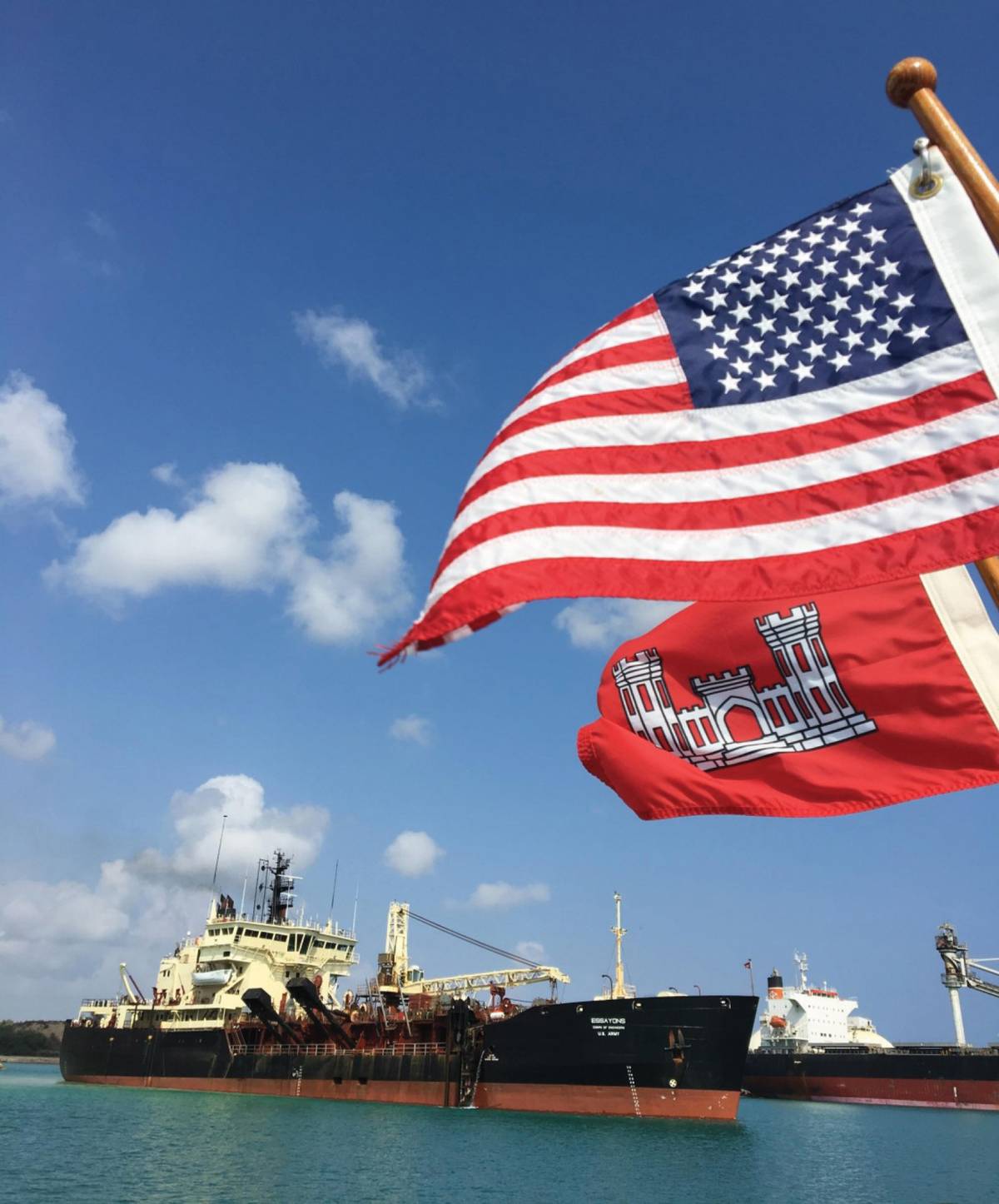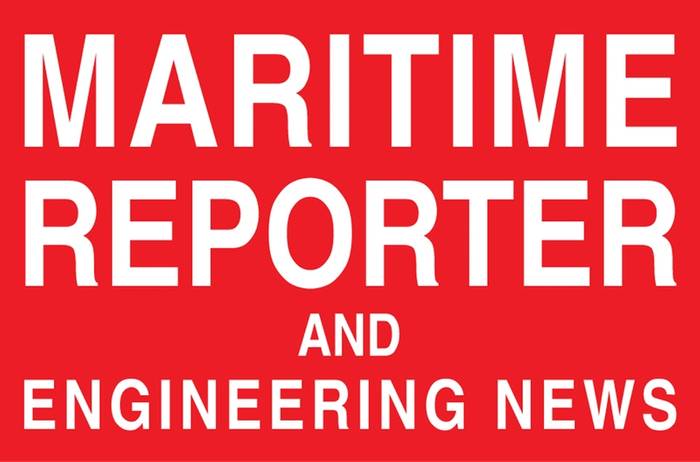Dredging Feature
U.S. Army Corps of Engineers
Dredging Deep(er) for Economic Security
The U.S. Army Corps of Engineers (USACE) operates on a simple mission: provide safe, reliable, efficient, effective, and environmentally sustainable waterborne transportation systems for movement of commerce, national security needs, and recreation. Jase Ousley, Deputy Chief of Navigation, U.S. Army Corps of Engineers, HQ, takes a deeper dive into the assets and priorities of the Corps to get the job done.
By Greg Trauthwein
To the general public, seeing an Army Corp of Engineers dredging operation in action – and realizing its significance to the U.S. economy – is a rarity indeed, as it could be argued that most only hear about the maritime sector when an accident occurs. But few realize the importance of the Corps specifically, the maritime industry in general, that is a cornerstone in keeping the $27T U.S. economy fluid. Of this total, the U.S. Marine Transportation Industry supports an estimated $2 trillion in commerce activity annually, with approximately 50% of all consumer goods bought by Americans passing through harbors maintained by the Corps. Today the Corps is responsible for 13,000 miles of coastal and deep draft channels, 12,000 miles of commercial inland and intracoastal waterways, and 1,072 coastal, great lakes, and inland harbors. On average the Corp dredges about 240 million cubic yards of sediment annually, a budget of approximately $2B. In FY23 the Corps issued contracts to more than 24 large and 53 small dredging businesses for $1.3B and $358M, respectively.
Jase Ousley has been with the Corps for 16 years, starting in engineering in Jacksonville FL working in navigation and on beach nourishment jobs that both involve dredging.
“I spent a couple years as a researcher at the Engineer Research and Development Center, Coastal and Hydraulics Laboratory,” said Ousley. “I’ve also worked in operations in Portland OR as the technical lead on a large pipeline dredge contract working in the Columbia River.”
The last four years he was working as the Dredging Program Manager at Corps Headquarters, but recently moved over to the Deputy Chief of Navigation, responsible for navigation budget development and overall execution of the navigation program supporting the Chief of Navigation, Tiffany Burroughs and the Corps’ Program Managers working on the various facets of the mission, coastal, inland, floating plant, environmental, dredging and dredged material placement, and supplemental work.

Drivers for Dredging
Today there are three main drivers for dredging activities: routine operations and maintenance (or O&M); construction - deepening and widening; and coastal storm risk reduction or sand mitigation, “which is basically building beaches and dunes,” said Ousley. The need to dredge is cyclical driven by things like shoaling, spring freshets, inclement weather, and protected species. “For example, we have windows to avoid right whales during calving season of the east coast,” he said.
In total, at the time of his interview, there were more than 100 dredges of different types working in California, Hawaii, the Gulf of Mexico and along the East Coast of the US. “Harbors in Alaska and the Great Lakes are iced in at the moment, so we aren’t doing work there, but we are putting out contracts for the coming dredging season,” said Ousley. The busiest area currently is in the Gulf of Mexico.
As he explained, the Corps budget is performance based and prioritizes projects with the highest economic, environmental, and public safety returns to the nation across the portfolio. “One of the major factors considered for routine O&M navigation work is the tonnage through a waterway or harbor,” said Ousley. “The top 10 ports by tonnage in the US are in Texas, South Louisiana servicing the MS river and tributaries, NY/NJ, VA, and CA. Additionally, we have 12 deepening projects under construction with a heavy concentration on the Texas coast.”
In tandem there are multiple, ongoing studies looking at “the economics and federal interest of deepening other ports to better accommodate larger vessels.”
In the last decade, widening of the Panama Canal created a tremendous push and opportunity for dredging activity, particularly on the gulf and east coast ports which needed to deepen and widen channels and port facilities to prepare for the much larger containerships … in some cases triple the previous size to 15,000+ TEU, that are now able to call on these ports. That work is ongoing, and in particular the COVID pandemic highlighted the need to broaden the capacity of ports to handle larger ships. “Generally, our channels and waterways are in good condition, but we were all impacted by COVID and supply chain issues over the last couple years,” said Ousley. “Many of the ports around the country had vessels in long queues waiting to load and unload cargo. We believe it will still take a couple years to fully realize changes as the land side infrastructure adapts from lessons learned, shifts goods distribution, expands, or rearranges staging and transfer to rail or truck.”
Longer term, all eyes are on the Arctic’s Northwest passage. “Climate change has done away with permanent ice and routes across Canadas northern border are becoming more frequent,” said Ousley. That water is naturally deep and would require less dredging in general, but that route is faster and without the size constraints of the Panama Canal, we could see even larger vessels calling on American ports.”
Looking Inland
While the coastal areas often garner the lion’s share of attention, inland waterways are critical commercial arteries serving the U.S. economic machine, and none more important than the Mississippi River, an essential gateway for U.S. agricultural products to world markets.
“The Mississippi River poses a unique challenge,” said Ousley. “Today we are in a good spot having recently ended low water operations, but we have been feeling the effects of weather extremes acutely in the Mississippi River system from record high water in 2019 to extreme low water the past two years. During high water events, the river undergoes rapid and extreme shoaling from the head of the passes out to the mouth of the river which places high demand for dredges from the commercial dredging fleet. During low water events, we require greater dredging further up in the river system, frequently a combination of Corps and industry dredges.”
A particularly interesting project last year was the Corps and its dredging industry partners working together in the building of a saltwater sill in the lower river to prevent salt water from the Gulf infiltrating the municipal freshwater intakes for New Orleans and other communities along the river.
But the challenges in managing climate extremes is not limited to the Mississippi River system, as “the Corps constructs an average of 10 beach nourishment projects a year to protect upland infrastructure from hurricanes and coastal storms,” said Ousley. This project count can easily be doubled after a particularly active hurricane season, and beach nourishment involves removing sediments from offshore or upland sand sources and placing that material on the beach.
“More frequent and intense storms shorten the life of the beaches, and results in a greater need for sand, which is a non-renewable natural resource,” said Ousley. “As we exhaust sediment deposits that are near shore, our partners in the dredging industry are challenged to build economically viable projects for the taxpayers with dredging equipment capable of removing sediments from further offshore at greater depths with longer haul distances. Meeting this need by adapting or recapitalizing dredge plants is a costly enterprise.”
But it’s a fight that needs to be fought, and it will continue. Climate resiliency is supported through initiatives like the beneficial use of dredged material, or BU.
“BU is using O&M sediments for productive and positive things like beach placement, marsh creation, or nourishing agricultural fields,” said Ousley. “From 1998-2021, the Corps used about 30-40% of our dredged material beneficially. In January of 2023, the Chief of Engineers LTG Spellmon, challenged the Corps to reach and sustain 70% BU by the year 2030. That is one of the greatest commitments to sustainability the Corps has made.” A great example where BU and climate change meet is New Jersey.
“There, our Philadelphia District works with congressional, state, resource agency and local stakeholders to renourish coastal marsh areas with dredged material to combat rising sea levels,” said Ousley.
The USACE Dredging Fleet
The Corps owns and operates four hopper dredges, three built in the early 1980’s, the fourth, the hopper dredge McFarland, was built in 1967 and is currently being recapitalized. “When the replacement is complete, the McFarland will be retired, and the new dredge will assume the McFarland’s position in the ready reserve fleet,” said Jase Ousley, Deputy Chief of Navigation, U.S. Army Corps of Engineers. “Our fleet also has three dustpan dredges, the Hurley built in 1993 and Potter and Jadwin built in 1932 and 1933, they are in their early 90’s, but still digging strong during low water in the Mississippi.”
Today, he said the Corps is in the midst of reviewing the timeline and lifecycle replacement of all government owned dredges. “We also have a pipeline dredge that works the upper Mississippi, two special purpose dredges that work small inlets and channels on the east and gulf coasts, and one side-caster that only works in North Carolina,” he said.
“In addition to the Corps hopper dredge, our industry partners have spent over $2 billion on capital investments in the commercial dredging fleet since 2018. There are three newer hoppers in service and two new hoppers expected to be delivered this year,” said Ousley.
This is a significant recapitalization, particularly “in a market where the 60% of the commercial hopper fleet is 40 plus years old. There have been six large cutterhead pipeline dredges, several new scows, and attendant plant added to the fleet, modernizing capability and improving capacity. Additionally, one company invested in innovative multi cats to make stringing pipeline together safer for their crew.”
Watch the full interview with Jase Ousley, Deputy Chief of Navigation, U.S. Army Corps of Engineers, HQ, on Maritime Reporter TV.


